The Portuguese archipelago of Madeira, nestled in the Atlantic Ocean off the coasts of Portugal and northern Africa, is normally a subtropical island paradise. But severe flooding on the island last weekend created a disaster that killed dozens and has local environmental leaders blaming the urban planning in the region as much as recent heavy rainfall. They believe that extensive development on the island of about 250,000 people over the last few decades created conditions that exacerbated the severe weather that struck over the weekend, when more than 11 cm of rain per fell in 5 hours in the town of Funchal–more than 15% of what it normally receives in an entire year.
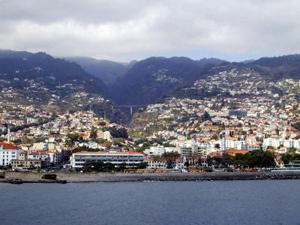
“The situation has gradually been aggravated due to land-use zoning problems and errors committed on the island,” said Hélder Spínola of Quercus, a Portuguese environmental organization. These “errors” include the development and paving of land along the coast and near waterways and disruption of the flow of Madeira’s three largest rivers. During the recent storm, the rivers overflowed, storm runoff did not effectively drain into the ground, and much of the water was forced into drainage channels that were unable to hold the tremendous amounts of rain. As a result, raging rivers of mud and debris stormed down the hillsides, plowing through roads, buildings, bridges, and anything else in their path. Adding to the problem was the absence of a weather radar in Madeira, which prevented an accurate forecast of the unusually strong storm.
While local government officials denied that faulty planning and overdevelopment were to blame for the catastrophe, research has long shown that urbanization increases frequency of flooding. For example, an upcoming article by Yang et al. in the Journal of Hydrometeorology finds that when the impervious surfaces cover more than a mere 3-5% of the total area in a watershed, there is a statistically significant effect on streamflow.
Uncategorized
The Rules of Removal
Like everything in life, snow removal has its rules and someone is always going to be unhappy with them. This is particularly true in places with relatively mild winters that occasionally get walloped, like Washington, D.C. this February.
What happens after the snow stops falling and residents and business owners are left with the job of clearing parking spots and sidewalks? What rules do they follow? In Boston, a city law states that by digging your car out in a snow emergency, the spot can then be claimed for two days by “saving” it with a lawn chair or trash can. In Chicago, this is illegal. In D.C., residents were left wondering.

“I know this is public property, but if you spent hours laboring, I mean, come on, I think you have the right to say that is my spot,” Tanya Barbour told the Washington Post after spending two hours shoveling her car out.
The sidewalk etiquette question is not much clearer. In portions of Maryland, business operators and multifamily homeowners have 24 hours after the snow ends to clean off sidewalks, or face a $50 fine; in Prince George’s County, owners get 48 hours before they can be fined $100. Much of Virginia does not issue penalties for not shoveling, but rather encourages residents and business owners to do so to help neighbors and keep customers safe.
One sidewalk angel quoted in the Washington Post, however, turned snow clearing into a philosophical question:
Steven Williams…noted that some people wait until the snow melts to make shoveling easier. “When is too early or too late to do anything in life?” he asked. “Who makes the rules?”
[We’re tempted to turn that into a meteorological question: If you wait until some of the snow melts, doesn’t that make it likely your shovel loads will be a lot heavier than if you’d cleared the freshly fallen flakes? Can one use the meteorological variables to calculate an index of procrastination due to precipitation?]
In the meantime, the most important rule of snow etiquette seems to be that enumerated by the Arlington, Virginia, blog, “Shirlington Circle” in their list of “snow paux”:
5. Build snow sculptures. DC sees so few inches per year…so try attempting a piece of architecture or a family-friendly snowperson. It also shows a neighborhood that plays together stays together.
Now, how to extend the etiquette of snow to martial arts of blizzards? The Official Dupont Circle Snowball Fight Fan Page on Facebook reached 5,000 members in anticipation of their scheduled February 6 battle in downtown D.C. The local media estimated the turnout at 2,000. That’s a great way to settle disputes over parking spots.
"Carbon Copy" Satellite Budgeted
Last year, NASA’s Orbiting Carbon Observatory left climate scientists disappointed when it failed before it even 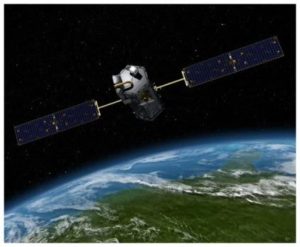 began. The $278 million satellite plunged into the Indian Ocean near Antarctica in February 2009 after a fairing on the probe’s Taurus XL rocket didn’t separate during launch. Now, the science community is hoping the sequel, OCO-2, will deliver what the first could not: measurements accurate enough to show for the first time the geographic distribution of carbon dioxide sources and sinks on a regional scale.
began. The $278 million satellite plunged into the Indian Ocean near Antarctica in February 2009 after a fairing on the probe’s Taurus XL rocket didn’t separate during launch. Now, the science community is hoping the sequel, OCO-2, will deliver what the first could not: measurements accurate enough to show for the first time the geographic distribution of carbon dioxide sources and sinks on a regional scale.
OCO principal investigator David Crisp of NASA’s Jet Propulsion Laboratory and his team evaluated the possibilities of getting another satellite up in space and chose to try again with the same design. “This is a carbon copy of the original,” Crisp comments, “with just a few minor, now-obsolete parts replaced.” Within three days after the failed launch, the OCO science team created a proposal for an OCO-2.
A year ensued, but as part of the 2011 Earth and Climate Science Budget released this month, the White House has now slotted $170 million for NASA to develop and fly OCO-2.
The new satellite is scheduled to be rebuilt and launched in 28 months, after 1 October of this year, when the budget would take effect if approved.
OCO isn’t the only mission to benefit in the Obama Administration’s proposed 2011 budget. Existing missions such as the Global Precipitation Measurement and the Landsat Data Continuity Mission will receive a monetary boost as well as several planned missions, such as the Glory mission, the NPOESS Preparatory Project mission, and the Aquarius mission.
Climate scientist Ken Caldeira of Stanford University was happy with the news of OCO returning to space. “The Orbiting Carbon Observatory is a key piece [of] the monitoring system that we need to keep track of our changing Earth, so that we might better understand the complex interplay of Earth’s climate system and carbon cycle, and therefore help to better inform the difficult climate-related decisions that we will need to make over the coming years and decades.”
Olympic-Sized Fear: No Snow
The Vancouver Winter Olympics begin on Friday with the first-ever opening ceremonies held indoors. That decision seems prescient on the part of the organizers, given that Friday’s forecast is calling for rain, and some Olympic officials may be starting to wish they had scheduled the entire games to be conducted under controlled conditions. According to Environment Canada’s Mike McDonald, one of 30 meteorologists working at the Games, Vancouver’s average temperature of 7.19°C (44.9°F) in January was the highest ever recorded for that month and about 3°C warmer than the normal average. The unusual warmth has continued into February and caused a paucity of snow at some venues–particularly at Cypress Mountain, the site of the freestyle skiing and snowboarding events (moguls, aerials, ski cross, half-pipe, snowboard cross, and parallel giant slalom).
The situation is so extreme that snow is continuously being shipped from other local mountains to Cypress by both truck and helicopter to ensure there is enough for competition.
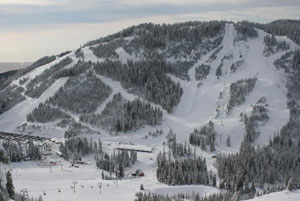
In addition to importing the snow, tubes filled with dry ice have been scattered across the mountain in a never-before-used technique that distributes cold air across the snow to help preserve it.
The weather conditions have many pointing to global warming and wondering if the number of potential host sites for the Winter Games may continue to decrease due to the spread of warmer weather. But as the University of Washington’s Cliff Mass explains in his blog, most meteorologists in the Vancouver region have an alternate suspect:
The problem, of course is El Niño. . . . As I have explained before El Niños are associated with above normal temperatures and below normal precip after January 1. And substantially lower than normal spring snowpacks. Now, lets be careful…this is a correlation, not an exact prediction. El Niño winters tend to have less snow, but some have had more than normal. Now the problem we have is that we are starting the El Niño season with a below normal snowpack. . . . Lots of the NW is 65-80% of normal.
The rising sea surface temperatures in the tropical Pacific that indicate an El Niño event were originally identified last summer, and what Mass calls a “moderate” El Niño has persisted through the winter and is expected to continue for months. Additionally, a flow of warm, moist air originating from around Hawaii known as the “pineapple express” could also be playing a part in the unusual warmth in the Pacific Northwest. And those blaming global warming should note that the Olympics have dealt with problems like these before, most notable in Innsbruck, Austria, in 1964, when a shortage of snow caused by a mild winter forced the Austrian army to carve out 20,000 bricks of ice to be used on the luge and bobsled runs, and also transport 40,000 cubic meters of snow to ski slopes, packing it down by hand.
With the additional snow arriving from other mountains, officials believe that the games will go on without a hitch, with Tim Gayda, vice president of sport for the Vancouver Olympic Organizing Committee, recently stating: “I am 100% confident that the events will take place and we’ll have enough snow to get the job done.”
This Day's for You
Paul Piorek, weathercaster for the local cable service News 12 in Connecticut, leads a busy life working a demanding shift schedule familiar to many meteorologists:
I wake up at 2 o’clock every morning, and I’m generally in the office by 3:05. People always ask me why I arrive so early if we don’t go on the air until 5:30. Believe me, it takes at least two hours to pour over the meteorological data, create customized graphics, provide local radio stations with recorded forecasts, write a weather discussion for the News 12 Connecticut Web site, begin working on a blog entry, and type the forecast for the info bar on the bottom of the screen. Despite what many people think, I just can’t “look out the window.”
The results don’t always bring accolades:
Although I’ve never been an umpire or referee, I think I know what it must feel like. It’s been said that nobody ever notices the umpire when he does a fine job. However, when the ump makes a bad call, everybody’s on his back. You see, I have been forecasting the weather for southwestern Connecticut on television and radio over the last 20-plus years. I never hear a word from anybody when the forecast is “right on the money.” But, if my forecast is off the mark, the phone doesn’t stop ringing and the emails keep coming.
But don’t feel sorry for Paul, because unlike so many other unsung heroes in life, he does it, like so many, because he loves the weather.
For me, though, it’s a labor of love. I often tell people, when you love what you do, you’ll never work a day in your life. Happy National Weatherperson’s Day!
What’s that? Oh yes, unlike so many unsung heroes in daily life, weather people get a day to celebrate being who we want to be. And it’s today because this is supposedly the birthday of John Jeffries, the Boston physician who was one of the first American weather enthusiasts of note; just in time for the American Revolution, before the age of storm chasing and broadcasting, he began 40 years of meticulous observing and indulged a daring penchant for ballooning to satisfy his hankering.
All in all it’s not bad to be into weather. Have a nice February 5th, whatever you call it, but keep your feet on the ground.

AMS Climate Briefing to Examine Health Issues
A search for the word “health” in the AMS Annual Meeting conference program brings up more than 180 hits, highlighting the current interest in understanding climate’s effects on human health (and the best ways to mitigate these effects). Tomorrow’s (February 5) AMS Climate Briefing in Washington, D.C., will address these issues with the help of three public health experts:
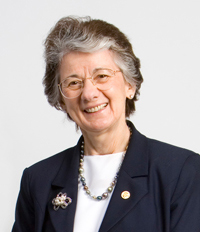
Dr. Rita Colwell of the University of Maryland and the Johns Hopkins School of Public Health will talk about the connection between environmental change (such as heat waves and hydrologic extremes) and disease risk, with a focus on infectious diseases, including both vector-borne (e.g., malaria, plague, and many viral diseases) and water-borne diseases (e.g., cholera). She will also discuss other effects such as mental health problems and civil disruption.
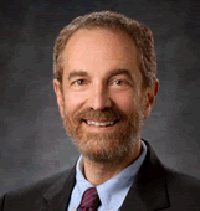
Dr. Howard Frumkin of the CDC will look at the framework for public health response to environmental threats that was developed at the CDC. Now being implemented at the federal, state, and local levels, the response involves such longstanding core public health activities as disease surveillance, outbreak investigations, vulnerability assessments, health communication, and preparedness planning. Additionally, he will highlight the importance of assessing the health consequences of mitigation strategies so that decision-makers can choose the most health-protective approaches.
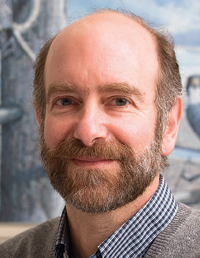
Dr. Jonathan Patz of the University of Wisconsin will explain the innovative strategy known as co-benefits, which promotes improved health while also mitigating climate change. For example, certain transportation strategies both limit travel demands and encourage walking and/or bicycling, thereby promoting positive health effects (such as reduced risk of cardiovascular disease, cancer, and asthma) as well as a cleaner environment. Dr. Patz will discuss recent U.S. studies suggesting that climate change mitigation could offer a substantial opportunity to improve public health and save billions of dollars in healthcare costs and worker productivity.
The hour-and-a-half long briefing is given twice on Capitol Hill: at 11 a.m. in Room 210 of the Cannon House Office Building and at 2 p.m in Room 406 of the Dirksen Senate Office Building.
A Record Nearly Lost in the Wind
A lot of fanfare surrounded the announcement in January (including our post here) that Barrow Island, a Brooklyn-size spot of land 31 miles off Australia’s northwest coast, now holds the record for the strongest recorded surface wind gust. The new record–a howling 253 mph (408 kph) during the passage of Tropical Cyclone Olivia on April 10, 1996–seemed worthy of instant fame. So, like many weather enthusiasts, we wondered why it took more than a decade for this immense wind to be recognized. The answer seems as amazing as the wind gust.
“There isn’t anything sinister about the 14 years delay in the TC Olivia wind record,” writes Randy Cerveny, of Arizona State University, in e-mail correspondence. Cerveny is a member of the World Meteorological Organization (WMO) panel that scrutinized and accepted the gust as a new wind record. “The basic truth is, unfortunately, the record was simply overlooked.”
Cerveny, a professor of climate studies at Arizona State University, explains that the high wind gusts—there were five—were measured on instrumentation owned by the private consulting company RPS MetOcean. Australia’s Bureau of Meteorology (BOM) was notified about the gusts, but considered them suspect since they were extraordinarily high for a 145 mph tropical cyclone, and because the accuracy of the equipment used to measure the gusts was unknown. Meteorologists at RPS MetOcean coauthored a paper on TC Olivia in 1999 and presented their findings at the small Offshore Technology Conference in Houston that year. A companion presentation explained the physical mechanism that likely generated the extreme gusts as a mesovortex in Olivia’s well-formed eyewall. But, then, the observations “fell through the research cracks,” Cerveny stated.
The panel of scientists charged with determining global weather and climate extremes as part of the WMO’s Commission for Climatology (CCl) only began looking into the TC Olivia wind gusts after completing an evaluation of the “new” record tropical cyclone wind gust of 211 mph measured during 2008’s Hurricane Gustav in Pinar del Rio, Cuba. The panel reviewed numerous exceptional wind gusts recorded in Olivia on Barrow Island and concluded that five peak gusts, ranging from 186 mph to the peak of 253 mph were indeed accurate. The other gusts measured 229 mph, 233 mph, and 215 mph, lending credibility to the record wind. So, not only did Olivia usurp Mt. Washington’s record surface wind, but it also eclipsed the just-recognized maximum wind gust in a tropical cyclone that Gustav produced.
As Jeff Masters of the Weather Underground noted in his online blog, Olivia was an intense tropical cyclone with gusts that crossed the 200 mph threshold of an EF-5 tornado, making them capable of causing catastrophic damage. Indeed, Olivia significantly damaged the oil and gas facilities on Barrow Island and nearby land areas in the region, and did extensive damage to homes inland in Mardie and Pannawonica in Western Australia.
Kenneth Spengler, 1915-2010
AMS Executive Director Emeritus Kenneth C. Spengler, a vital force in the growth of the AMS after World War II, passed away yesterday at the age of 94. 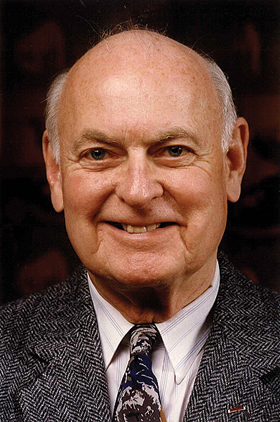 Dr. Spengler was executive director of the AMS from 1946 to 1988, leading the Society at a time when membership surged from 2,000 to about 10,000. In 1958, he negotiated the acquisition of the current AMS Headquarters building at 45 Beacon Street in Boston.
Dr. Spengler was executive director of the AMS from 1946 to 1988, leading the Society at a time when membership surged from 2,000 to about 10,000. In 1958, he negotiated the acquisition of the current AMS Headquarters building at 45 Beacon Street in Boston.
The entire AMS community extends its condolences to Dr. Spengler’s family. We invite our readers to share their favorite stories and memories of Dr. Spengler in the comments.
UPDATE: The wake for Dr. Spengler will be held on Sunday, January 31, from 3:00 to 7:00 p.m. at the Douglass Funeral Home in Lexington, Massachusetts. There will be a short service at the same location on Monday at 10:00 a.m., and the funeral will be at Sacred Heart Church in Lexington at 11:00 a.m.
Security and Climate Panel Videos
Yesterday, Clean Skies News, the energy and environment network, posted several videos from the AMS meeting in Atlanta. They focused on the panel sessions on national security and climate change (see our previous posts here and here). One of the co-chairs, AMS Councilor Ken Carey, of Noblis, was interviewed afterward, and he emphasized that environmental awareness and preparedness for the national security community, like climate change itself, will continue over “the long haul”:
Also taped in an interview afterward was panelist Rear Admiral David Titley, who discussed the Navy’s scientific and strategic interests in climate change:
Clean Skies News also posted about half the panel discussion, in three parts:
Is Science Messy Enough for You?
Brooks Garner, broadcast meteorologist with WIS-TV in Columbia, South Carolina, shares on his blog some interesting impressions from the climate variability and change sessions at the recent AMS meeting in Atlanta. He notes that the process of science we witnessed at the AMS meeting doesn’t fit the pace of the contemporary mindset:
In a culture characterized by the hunger for “instant gratification” (“IG”) in everything from consumerism to relationships, naturally science is struggling through the same tide….
He witnesses some contentious arguments, glaring discrecpancies in interpretations, and clashing priorities that fueled some occasionally tense sessions in Atlanta, like a science “reality show.” Even amid this scientific culture of constant debate and disagreement and incremental progress in understanding, Garner can see that experts overwhelmingly agree that warming is happening and we can’t ignore the consequences. He can also see why the public is not always convinced
[I]nstant gratification will never occur on the topic of global warming. Science will never agree completely in its effects or a solution. But one thing I can guarantee you: the research will never stop, the debate will never cool, and the naysayer’s will never rest. If they did, it would no longer be ‘science’, but instead ‘belief’.
Then he adds a piece of good advice:
Do you “believe” in global warming? I hope not. I hope that everyone would stop “believing” and instead spend that energy learning as much as possible about the subject.
This attitude is the antithesis of instant gratifcation; one striking aspect of Garner’s viewpoint is how similar it is to another blogger-scientist who posted not long after the East Anglia e-mails made the news.
Thomas Zurbuchen is Associate Dean at the Center for Entrepreneurship in the College of Engineering of the University of Michigan. In a posting titled, “Messy Science,” Zurbuchen wrote that the scientists’ e-mails didn’t tell him anything new about climate change, but the huge number of comments about the e-mails he’d received were disturbing.
I am left with a deep sense that most people don’t understand science, or its pursuit. Doing science is more like orienteering, and less like a 100 meter dash. Doing science is messy!
“Most people” includes science grad students, Zurbuchen says. A lot of grad students expect quick success–or at least steady success with every project. They don’t realize that a lot of ideas and hard work are flushed away by competing evidence.
To most budding scientists, this leads to a major crisis. Now, they have to decide whether they want to be a scientist! As they go forward, they notice that science is about search, and struggles. It is about false starts, about failed projects. It’s not about victory [laps]….
The East Anglia e-mails, he said, showed how frustrated scientists can become, which leads to all sorts of behavior, including lashing out at the peer review system. While an instant gratification culture may not be able to embrace scientists’ oft-fallible responses to a rock-solid, rock-slow process, Zurbuchen, like Garner, sees signs of the health of the enterprise despite the humanity of the participants:
Yes, science is not an orderly, straightforward path. It is littered with messy turns and twists. For me, that has been the only reason I have become a scientist. If it was predictable, everybody could be a successful scientist!